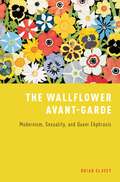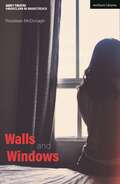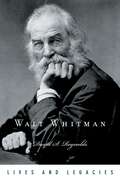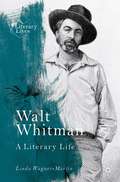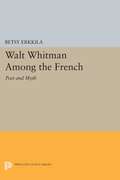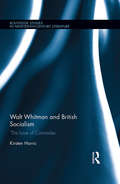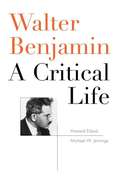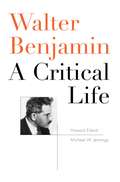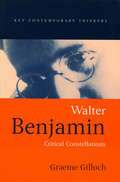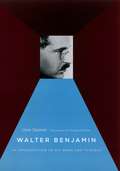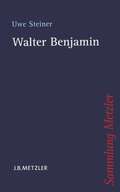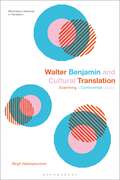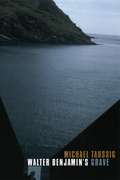- Table View
- List View
The Wallflower Avant-Garde: Modernism, Sexuality, and Queer Ekphrasis
by Brian GlaveyThe Wallflower Avant-Garde highlights a strain of formalism visible in both modernist literature and contemporary queer studies, drawing attention to an aesthetic that is as quiet and quirky as it is queer. In studies of Gertrude Stein, Djuna Barnes, Richard Bruce Nugent, Frank O'Hara, and John Ashbery, Brian Glavey argues for a recalibrated understanding of the relation between sexuality and the aesthetic, revealing a non-oppositional avant-gardism that opts out of some of the binaristic imperatives that have structured recent debates in queer theory. Refusing to decide between positive and negative affects or to side with either utopian or antisocial ambitions, The Wallflower Avant-Garde explores models of reading and writing about art that remain flexible enough to dig deep even as they gloss the surface. At the heart of this argument is a revaluation of modernist ekphrasis, a mode understood as literature's imitation or description of the visual arts. From the well-wrought urns of the New Critics onward, ekphrasis has figured prominently in the legacy of modernist literary criticism, but a tendency to read its complicated modes of relationality in terms of either autonomy or antagonism has obscured the forms of creative failure and imitation embodied in the desire to confuse poetry for pottery. Attending to mimetic and descriptive strategies without dismissing the aspirations for wholeness and closure that often animate them allows for the recognition that queerness and modernism are intertwined in unexpected and unpredictable ways, revealing new insights into the varieties of abstraction, preterition, and spatial form that stand behind modernism's investment in the aesthetic.
Walls and Windows (Modern Plays)
by Rosaleen McDonaghLads, when it comes to your time for pickin' women, you're not going to have my kind of luck. The best one is taken.All Julia and John want is to live their lives with their two sons, on their own terms. But despite their hopes, the outside world and its racism puts paid to their plans. A world premiere of a new play from Rosaleen McDonagh, this tender, complex and beautiful love story examines how external circumstances pull us apart, when all we really want is to be together.This edition was published to coincide with the world premiere at Abbey Theatre, Dublin, in August 2021
Walls and Windows (Modern Plays)
by Rosaleen McDonaghLads, when it comes to your time for pickin' women, you're not going to have my kind of luck. The best one is taken.All Julia and John want is to live their lives with their two sons, on their own terms. But despite their hopes, the outside world and its racism puts paid to their plans. A world premiere of a new play from Rosaleen McDonagh, this tender, complex and beautiful love story examines how external circumstances pull us apart, when all we really want is to be together.This edition was published to coincide with the world premiere at Abbey Theatre, Dublin, in August 2021
Walsingham in Literature and Culture from the Middle Ages to Modernity
by DOMINIC JANES AND GARY WALLERWalsingham was medieval England's most important shrine to the Virgin Mary and a popular pilgrimage site. Following its modern revival it is also well known today. For nearly a thousand years, it has been the subject of, or referred to in, music, poetry and novels (by for instance Langland, Erasmus, Sidney, Shakespeare, Hopkins, Eliot and Lowell). But only in the last twenty years or so has it received serious scholarly attention. This volume represents the first collection of multi-disciplinary essays on Walsingham's broader cultural significance. Contributors to this book focus on the hitherto neglected issue of Walsingham's cultural impact: the literary, historical, art historical and sociological significance that Walsingham has had for over six hundred years. The collection's essays consider connections between landscape and the sacred, the body and sexuality and Walsingham's place in literature, music and, more broadly, especially since the Reformation, in the construction of cultural memory. The historical range of the essays includes Walsingham's rise to prominence in the later Middle Ages, its destruction during the English Reformation, and the presence of uncanny echoes and traces in early modern English culture, including poems, ballads, music and some of the plays of Shakespeare. Contributions also examine the cultural dynamics of the remarkable revival of Walsingham as a place of pilgrimage and as a cultural icon in the Victorian and modern periods. Hitherto, scholarship on Walsingham has been almost entirely confined to the history of religion. In contrast, contributors to this volume include internationally known scholars from literature, cultural studies, history, sociology, anthropology and musicology as well as theology.
Walsingham in Literature and Culture from the Middle Ages to Modernity
by Dominic Janes Gary WallerWalsingham was medieval England's most important shrine to the Virgin Mary and a popular pilgrimage site. Following its modern revival it is also well known today. For nearly a thousand years, it has been the subject of, or referred to in, music, poetry and novels (by for instance Langland, Erasmus, Sidney, Shakespeare, Hopkins, Eliot and Lowell). But only in the last twenty years or so has it received serious scholarly attention. This volume represents the first collection of multi-disciplinary essays on Walsingham's broader cultural significance. Contributors to this book focus on the hitherto neglected issue of Walsingham's cultural impact: the literary, historical, art historical and sociological significance that Walsingham has had for over six hundred years. The collection's essays consider connections between landscape and the sacred, the body and sexuality and Walsingham's place in literature, music and, more broadly, especially since the Reformation, in the construction of cultural memory. The historical range of the essays includes Walsingham's rise to prominence in the later Middle Ages, its destruction during the English Reformation, and the presence of uncanny echoes and traces in early modern English culture, including poems, ballads, music and some of the plays of Shakespeare. Contributions also examine the cultural dynamics of the remarkable revival of Walsingham as a place of pilgrimage and as a cultural icon in the Victorian and modern periods. Hitherto, scholarship on Walsingham has been almost entirely confined to the history of religion. In contrast, contributors to this volume include internationally known scholars from literature, cultural studies, history, sociology, anthropology and musicology as well as theology.
Walt Whitman (Lives and Legacies Series)
by David S. ReynoldsFrom the great events of the day to the patient workings of a spider, few poets responded to the life around them as powerfully as Walt Whitman. Now, in this brief but bountiful volume, David S. Reynolds offers a wealth of insight into the life and work of Whitman, examining the author through the lens of nineteenth-century America. Reynolds shows how Whitman responded to contemporary theater, music, painting, photography, science, religion, and sex. But perhaps nothing influenced Whitman more than the political events of his lifetime, as the struggle over slavery threatened to rip apart the national fabric. America, he believed, desperately needed a poet to hold together a society that was on the verge of unraveling. He created his powerful, all-absorbing poetic "I" to heal a fragmented nation that, he hoped, would find in his poetry new possibilities for inspiration and togetherness. Reynolds also examines the influence of theater, describing how Whitman's favorite actor, the tragedian Junius Brutus Booth--"one of the grandest revelations of my life"--developed a powerfully emotive stage style that influenced Leaves of Grass, which took passionate poetic expression to new heights. Readers will also discover how from the new medium of photography Whitman learned democratic realism and offered in his poetry "photographs" of common people engaged in everyday activities. Reynolds concludes with an appraisal of Whitman's impact on American letters, an influence that remains strong today. Solidly grounded in historical and biographical facts, and exceptionally wide-ranging in the themes it treats, Walt Whitman packs a dazzling amount of insight into a compact volume.
Walt Whitman (Lives and Legacies Series)
by David S. ReynoldsFrom the great events of the day to the patient workings of a spider, few poets responded to the life around them as powerfully as Walt Whitman. Now, in this brief but bountiful volume, David S. Reynolds offers a wealth of insight into the life and work of Whitman, examining the author through the lens of nineteenth-century America. Reynolds shows how Whitman responded to contemporary theater, music, painting, photography, science, religion, and sex. But perhaps nothing influenced Whitman more than the political events of his lifetime, as the struggle over slavery threatened to rip apart the national fabric. America, he believed, desperately needed a poet to hold together a society that was on the verge of unraveling. He created his powerful, all-absorbing poetic "I" to heal a fragmented nation that, he hoped, would find in his poetry new possibilities for inspiration and togetherness. Reynolds also examines the influence of theater, describing how Whitman's favorite actor, the tragedian Junius Brutus Booth--"one of the grandest revelations of my life"--developed a powerfully emotive stage style that influenced Leaves of Grass, which took passionate poetic expression to new heights. Readers will also discover how from the new medium of photography Whitman learned democratic realism and offered in his poetry "photographs" of common people engaged in everyday activities. Reynolds concludes with an appraisal of Whitman's impact on American letters, an influence that remains strong today. Solidly grounded in historical and biographical facts, and exceptionally wide-ranging in the themes it treats, Walt Whitman packs a dazzling amount of insight into a compact volume.
Walt Whitman: A Literary Life (Literary Lives)
by Linda Wagner-MartinWalt Whitman: A Literary Life highlights two major influences on Whitman’s poetry and life: the American Civil War and his economic condition. Linda Wagner-Martin performs a close reading of many of Whitman’s poems, particularly his Civil War work (in Drum-Taps) and those poems written during the last twenty years of his life. Wagner-Martin’s study also emphasizes the near-poverty that Whitman experienced. Starting with his early career as a printer and journalist, the book moves to the publication of Leaves of Grass, and his cultivation of the persona of the “working-class” writer. In addition to establishing Whitman’s attention to the Civil War through journalism and memoirs, the book takes the approach of following Whitman’s life through his poems. Utilizing contemporary perspectives on class, Wagner-Martin provides a new reading of Whitman’s economic situation. This is an accessibly written synthesis of Whitman’s publication history bringing attention to under-studied aspects of his writing.
Walt Whitman Among the French: Poet and Myth
by Betsy ErkkilaAs the first full treatment of Walt Whitman's French sources and his later impact on French writers, this book revises our image of the poet and challenges many critical assumptions.Originally published in 1980.The Princeton Legacy Library uses the latest print-on-demand technology to again make available previously out-of-print books from the distinguished backlist of Princeton University Press. These editions preserve the original texts of these important books while presenting them in durable paperback and hardcover editions. The goal of the Princeton Legacy Library is to vastly increase access to the rich scholarly heritage found in the thousands of books published by Princeton University Press since its founding in 1905.
Walt Whitman and British Socialism: ‘The Love of Comrades’ (Routledge Studies in Nineteenth Century Literature)
by Kirsten HarrisThis is the first sustained examination of Walt Whitman’s influence on British socialism. Harris combines a contextual historical study of Whitman’s reception with focused close readings of a variety of poems, books, articles, letters and speeches. She calls attention to Whitman’s own demand for the reader to ‘himself or herself construct indeed the poem, argument, history, metaphysical essay’, linking Whitman’s general comments about active reading to specific cases of his fin de siècle British socialist readership. These include the editorial aims behind the Whitman selections published by William Michael Rossetti, Ernest Rhys, and W. T. Stead and the ways that Whitman was interpreted and appropriated in a wide range of grassroots texts produced by individuals or groups who responded to Whitman and his poetry publicly in socialist circles. Harris makes full use of material from the C. F. Sixsmith and J. W. Wallace and the Bolton Whitman Fellowship collections at John Rylands, the Edward Carpenter collection in the Sheffield Archives, and the Archives of Swan Sonnenschein & Co. at the University of Reading. Much of this archive material – little of which is currently available in digital form – is discussed here in full for the first time. Accordingly, this study will appeal to those with interest in the archival history of nineteenth-century literary culture, as well as the connections to be made between literary and political culture of this era more generally.
Walt Whitman and British Socialism: ‘The Love of Comrades’ (Routledge Studies in Nineteenth Century Literature)
by Kirsten HarrisThis is the first sustained examination of Walt Whitman’s influence on British socialism. Harris combines a contextual historical study of Whitman’s reception with focused close readings of a variety of poems, books, articles, letters and speeches. She calls attention to Whitman’s own demand for the reader to ‘himself or herself construct indeed the poem, argument, history, metaphysical essay’, linking Whitman’s general comments about active reading to specific cases of his fin de siècle British socialist readership. These include the editorial aims behind the Whitman selections published by William Michael Rossetti, Ernest Rhys, and W. T. Stead and the ways that Whitman was interpreted and appropriated in a wide range of grassroots texts produced by individuals or groups who responded to Whitman and his poetry publicly in socialist circles. Harris makes full use of material from the C. F. Sixsmith and J. W. Wallace and the Bolton Whitman Fellowship collections at John Rylands, the Edward Carpenter collection in the Sheffield Archives, and the Archives of Swan Sonnenschein & Co. at the University of Reading. Much of this archive material – little of which is currently available in digital form – is discussed here in full for the first time. Accordingly, this study will appeal to those with interest in the archival history of nineteenth-century literary culture, as well as the connections to be made between literary and political culture of this era more generally.
Walter Benjamin: A Critical Life
by Howard EilandWalter Benjamin was perhaps the twentieth century's most elusive intellectual. His writings defy categorization, and his improvised existence has proven irresistible to mythologizers. In a major new biography, Howard Eiland and Michael Jennings present a comprehensive portrait of the man and his times, as well as extensive commentary on his work.
Walter Benjamin: A Critical Life (Walter Benjamin Ser. #Vol. 1)
by Howard EilandWalter Benjamin was perhaps the twentieth century's most elusive intellectual. His writings defy categorization, and his improvised existence has proven irresistible to mythologizers. In a major new biography, Howard Eiland and Michael Jennings present a comprehensive portrait of the man and his times, as well as extensive commentary on his work.
Walter Benjamin: Critical Constellations (Key Contemporary Thinkers)
by Graeme GillochThe works of Walter Benjamin (1892-1940) are widely acclaimed as being among the most original and provocative writings of twentieth-century critical thought, and have become required reading for scholars and students in a range of academic disciplines. This book provides a lucid introduction to Benjamin's oeuvre through a close and sensitive reading not only of his major studies, but also of some of his less familiar essays and fragments. Gilloch offers an original interpretation of, and fresh insights into, the continuities between Benjamin's always demanding and seemingly disparate texts. Gilloch's book will be of particular interest to students and scholars in social theory, literary theory, cultural and media studies and urban studies who are seeking a sophisticated yet readable overview of Benjamin's work. It will also prove rewarding reading for those already well-versed in Benjaminian thought.
Walter Benjamin: Critical Constellations (Key Contemporary Thinkers)
by Graeme GillochThe works of Walter Benjamin (1892-1940) are widely acclaimed as being among the most original and provocative writings of twentieth-century critical thought, and have become required reading for scholars and students in a range of academic disciplines. This book provides a lucid introduction to Benjamin's oeuvre through a close and sensitive reading not only of his major studies, but also of some of his less familiar essays and fragments. Gilloch offers an original interpretation of, and fresh insights into, the continuities between Benjamin's always demanding and seemingly disparate texts. Gilloch's book will be of particular interest to students and scholars in social theory, literary theory, cultural and media studies and urban studies who are seeking a sophisticated yet readable overview of Benjamin's work. It will also prove rewarding reading for those already well-versed in Benjaminian thought.
Walter Benjamin: An Introduction to His Work and Thought
by Uwe SteinerSeven decades after his death, German Jewish writer, philosopher, and literary critic Walter Benjamin (1892–1940) continues to fascinate and influence. Here Uwe Steiner offers a comprehensive and sophisticated introduction to the oeuvre of this intriguing theorist. Acknowledged only by a small circle of intellectuals during his lifetime, Benjamin is now a major figure whose work is essential to an understanding of modernity. Steiner traces the development of Benjamin’s thought chronologically through his writings on philosophy, literature, history, politics, the media, art, photography, cinema, technology, and theology. Walter Benjamin reveals the essential coherence of its subject’s thinking while also analyzing the controversial or puzzling facets of Benjamin’s work. That coherence, Steiner contends, can best be appreciated by placing Benjamin in his proper context as a member of the German philosophical tradition and a participant in contemporary intellectual debates. As Benjamin’s writing attracts more and more readers in the English-speaking world, Walter Benjamin will be a valuable guide to this fascinating body of work.
Walter Benjamin: An Introduction to His Work and Thought
by Uwe SteinerSeven decades after his death, German Jewish writer, philosopher, and literary critic Walter Benjamin (1892–1940) continues to fascinate and influence. Here Uwe Steiner offers a comprehensive and sophisticated introduction to the oeuvre of this intriguing theorist. Acknowledged only by a small circle of intellectuals during his lifetime, Benjamin is now a major figure whose work is essential to an understanding of modernity. Steiner traces the development of Benjamin’s thought chronologically through his writings on philosophy, literature, history, politics, the media, art, photography, cinema, technology, and theology. Walter Benjamin reveals the essential coherence of its subject’s thinking while also analyzing the controversial or puzzling facets of Benjamin’s work. That coherence, Steiner contends, can best be appreciated by placing Benjamin in his proper context as a member of the German philosophical tradition and a participant in contemporary intellectual debates. As Benjamin’s writing attracts more and more readers in the English-speaking world, Walter Benjamin will be a valuable guide to this fascinating body of work.
Walter Benjamin: An Introduction to His Work and Thought
by Uwe SteinerSeven decades after his death, German Jewish writer, philosopher, and literary critic Walter Benjamin (1892–1940) continues to fascinate and influence. Here Uwe Steiner offers a comprehensive and sophisticated introduction to the oeuvre of this intriguing theorist. Acknowledged only by a small circle of intellectuals during his lifetime, Benjamin is now a major figure whose work is essential to an understanding of modernity. Steiner traces the development of Benjamin’s thought chronologically through his writings on philosophy, literature, history, politics, the media, art, photography, cinema, technology, and theology. Walter Benjamin reveals the essential coherence of its subject’s thinking while also analyzing the controversial or puzzling facets of Benjamin’s work. That coherence, Steiner contends, can best be appreciated by placing Benjamin in his proper context as a member of the German philosophical tradition and a participant in contemporary intellectual debates. As Benjamin’s writing attracts more and more readers in the English-speaking world, Walter Benjamin will be a valuable guide to this fascinating body of work.
Walter Benjamin (Sammlung Metzler)
by Uwe SteinerZu Lebzeiten als Germanist gescheitert, nach seinem Tode als Ideengeber der Literatur und Philosophie geschätzt. Warum erscheint Benjamins Denken heute so aktuell? Immer wieder variierte er in Essays und Kritiken sein großes Thema: die Moderne in Kunst, Technik und Politik. Motiv für zahlreiche Kontroversen um die gültige Auslegung. Die Einführung entrümpelt das Werk von falschen Vereinnahmungen und zeigt einen Denker, der seiner Zeit voraus war.
Walter Benjamin and Cultural Translation: Examining a Controversial Legacy (Bloomsbury Advances in Translation)
by Birgit HaberpeuntnerDissecting the radical impact of Walter Benjamin on contemporary cultural, postcolonial and translation theory, this book investigates the translation and reception of Benjamin's most famous text about translation, “The Task of the Translator,” in English language debates around 'cultural translation'. For years now, there has been a pronounced interest in translation throughout the Humanities, which has come with an increasing detachment of translation from linguistic-textual parameters. It has generated a broad spectrum of discussions subsumed under the heading of 'cultural translation', a concept that is constantly re-invented and manifests in often heavily diverging expressions. However, there seems to be a distinct constant: In their own (re-)formulations of this concept, a remarkable number of scholars-Bhabha, Chow, Niranjana, to name but a few-explicitly refer to Walter Benjamin's “The Task of the Translator.” In its first part, this book considers Benjamin and the way in which he thought about, theorized and practiced translation throughout his writings. In a second part, Walter Benjamin meets 'cultural translation': tracing various paths of translation and reception, this part also tackles the issues and debates that result from the omnipresence of Walter Benjamin in contemporary theories and discussions of 'cultural translation'. The result is a clearer picture of the translation and reception processes that have generated the immense impact of Benjamin on contemporary cultural theory, as well as new perspectives for a way of reading that re-shapes the canonized texts themselves and holds the potential of disturbing, shifting and enriching their more 'traditional' readings.
Walter Benjamin and Cultural Translation: Examining a Controversial Legacy (Bloomsbury Advances in Translation)
by Birgit HaberpeuntnerDissecting the radical impact of Walter Benjamin on contemporary cultural, postcolonial and translation theory, this book investigates the translation and reception of Benjamin's most famous text about translation, “The Task of the Translator,” in English language debates around 'cultural translation'. For years now, there has been a pronounced interest in translation throughout the Humanities, which has come with an increasing detachment of translation from linguistic-textual parameters. It has generated a broad spectrum of discussions subsumed under the heading of 'cultural translation', a concept that is constantly re-invented and manifests in often heavily diverging expressions. However, there seems to be a distinct constant: In their own (re-)formulations of this concept, a remarkable number of scholars-Bhabha, Chow, Niranjana, to name but a few-explicitly refer to Walter Benjamin's “The Task of the Translator.” In its first part, this book considers Benjamin and the way in which he thought about, theorized and practiced translation throughout his writings. In a second part, Walter Benjamin meets 'cultural translation': tracing various paths of translation and reception, this part also tackles the issues and debates that result from the omnipresence of Walter Benjamin in contemporary theories and discussions of 'cultural translation'. The result is a clearer picture of the translation and reception processes that have generated the immense impact of Benjamin on contemporary cultural theory, as well as new perspectives for a way of reading that re-shapes the canonized texts themselves and holds the potential of disturbing, shifting and enriching their more 'traditional' readings.
Walter Benjamin's Grave
by Michael TaussigIn September 1940, Walter Benjamin committed suicide in Port Bou on the Spanish-French border when it appeared that he and his travelling partners would be denied passage into Spain in their attempt to escape the Nazis. In 2002, one of anthropology’s—and indeed today’s—most distinctive writers, Michael Taussig, visited Benjamin’s grave in Port Bou. The result is “Walter Benjamin’s Grave,” a moving essay about the cemetery, eyewitness accounts of Benjamin’s border travails, and the circumstances of his demise. It is the most recent of eight revelatory essays collected in this volume of the same name. “Looking over these essays written over the past decade,” writes Taussig, “I think what they share is a love of muted and defective storytelling as a form of analysis. Strange love indeed; love of the wound, love of the last gasp.” Although thematically these essays run the gamut—covering the monument and graveyard at Port Bou, discussions of peasant poetry in Colombia, a pact with the devil, the peculiarities of a shaman’s body, transgression, the disappearance of the sea, New York City cops, and the relationship between flowers and violence—each shares Taussig’s highly individual brand of storytelling, one that depends on a deep appreciation of objects and things as a way to retrieve even deeper philosophical and anthropological meanings. Whether he finds himself in Australia, Colombia, Manhattan, or Spain, in the midst of a book or a beach, whether talking to friends or staring at a monument, Taussig makes clear through these marvelous essays that materialist knowledge offers a crucial alternative to the increasingly abstract, globalized, homogenized, and digitized world we inhabit. Pursuing an adventure that is part ethnography, part autobiography, and part cultural criticism refracted through the object that is Walter Benjamin’s grave, Taussig, with this collection, provides his own literary memorial to the twentieth century’s greatest cultural critic.
Walter Benjamin's Grave
by Michael TaussigIn September 1940, Walter Benjamin committed suicide in Port Bou on the Spanish-French border when it appeared that he and his travelling partners would be denied passage into Spain in their attempt to escape the Nazis. In 2002, one of anthropology’s—and indeed today’s—most distinctive writers, Michael Taussig, visited Benjamin’s grave in Port Bou. The result is “Walter Benjamin’s Grave,” a moving essay about the cemetery, eyewitness accounts of Benjamin’s border travails, and the circumstances of his demise. It is the most recent of eight revelatory essays collected in this volume of the same name. “Looking over these essays written over the past decade,” writes Taussig, “I think what they share is a love of muted and defective storytelling as a form of analysis. Strange love indeed; love of the wound, love of the last gasp.” Although thematically these essays run the gamut—covering the monument and graveyard at Port Bou, discussions of peasant poetry in Colombia, a pact with the devil, the peculiarities of a shaman’s body, transgression, the disappearance of the sea, New York City cops, and the relationship between flowers and violence—each shares Taussig’s highly individual brand of storytelling, one that depends on a deep appreciation of objects and things as a way to retrieve even deeper philosophical and anthropological meanings. Whether he finds himself in Australia, Colombia, Manhattan, or Spain, in the midst of a book or a beach, whether talking to friends or staring at a monument, Taussig makes clear through these marvelous essays that materialist knowledge offers a crucial alternative to the increasingly abstract, globalized, homogenized, and digitized world we inhabit. Pursuing an adventure that is part ethnography, part autobiography, and part cultural criticism refracted through the object that is Walter Benjamin’s grave, Taussig, with this collection, provides his own literary memorial to the twentieth century’s greatest cultural critic.
Walter Benjamin's Grave
by Michael TaussigIn September 1940, Walter Benjamin committed suicide in Port Bou on the Spanish-French border when it appeared that he and his travelling partners would be denied passage into Spain in their attempt to escape the Nazis. In 2002, one of anthropology’s—and indeed today’s—most distinctive writers, Michael Taussig, visited Benjamin’s grave in Port Bou. The result is “Walter Benjamin’s Grave,” a moving essay about the cemetery, eyewitness accounts of Benjamin’s border travails, and the circumstances of his demise. It is the most recent of eight revelatory essays collected in this volume of the same name. “Looking over these essays written over the past decade,” writes Taussig, “I think what they share is a love of muted and defective storytelling as a form of analysis. Strange love indeed; love of the wound, love of the last gasp.” Although thematically these essays run the gamut—covering the monument and graveyard at Port Bou, discussions of peasant poetry in Colombia, a pact with the devil, the peculiarities of a shaman’s body, transgression, the disappearance of the sea, New York City cops, and the relationship between flowers and violence—each shares Taussig’s highly individual brand of storytelling, one that depends on a deep appreciation of objects and things as a way to retrieve even deeper philosophical and anthropological meanings. Whether he finds himself in Australia, Colombia, Manhattan, or Spain, in the midst of a book or a beach, whether talking to friends or staring at a monument, Taussig makes clear through these marvelous essays that materialist knowledge offers a crucial alternative to the increasingly abstract, globalized, homogenized, and digitized world we inhabit. Pursuing an adventure that is part ethnography, part autobiography, and part cultural criticism refracted through the object that is Walter Benjamin’s grave, Taussig, with this collection, provides his own literary memorial to the twentieth century’s greatest cultural critic.
Walter Benjamin's Grave
by Michael TaussigIn September 1940, Walter Benjamin committed suicide in Port Bou on the Spanish-French border when it appeared that he and his travelling partners would be denied passage into Spain in their attempt to escape the Nazis. In 2002, one of anthropology’s—and indeed today’s—most distinctive writers, Michael Taussig, visited Benjamin’s grave in Port Bou. The result is “Walter Benjamin’s Grave,” a moving essay about the cemetery, eyewitness accounts of Benjamin’s border travails, and the circumstances of his demise. It is the most recent of eight revelatory essays collected in this volume of the same name. “Looking over these essays written over the past decade,” writes Taussig, “I think what they share is a love of muted and defective storytelling as a form of analysis. Strange love indeed; love of the wound, love of the last gasp.” Although thematically these essays run the gamut—covering the monument and graveyard at Port Bou, discussions of peasant poetry in Colombia, a pact with the devil, the peculiarities of a shaman’s body, transgression, the disappearance of the sea, New York City cops, and the relationship between flowers and violence—each shares Taussig’s highly individual brand of storytelling, one that depends on a deep appreciation of objects and things as a way to retrieve even deeper philosophical and anthropological meanings. Whether he finds himself in Australia, Colombia, Manhattan, or Spain, in the midst of a book or a beach, whether talking to friends or staring at a monument, Taussig makes clear through these marvelous essays that materialist knowledge offers a crucial alternative to the increasingly abstract, globalized, homogenized, and digitized world we inhabit. Pursuing an adventure that is part ethnography, part autobiography, and part cultural criticism refracted through the object that is Walter Benjamin’s grave, Taussig, with this collection, provides his own literary memorial to the twentieth century’s greatest cultural critic.
